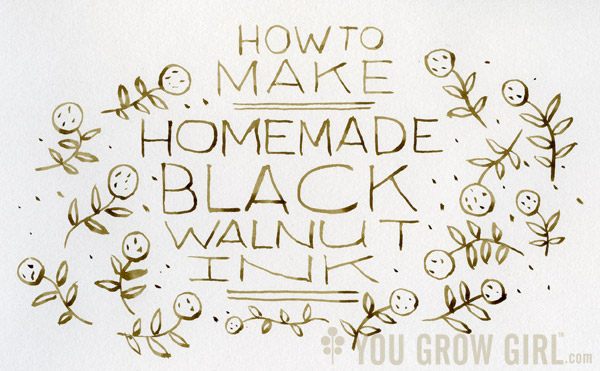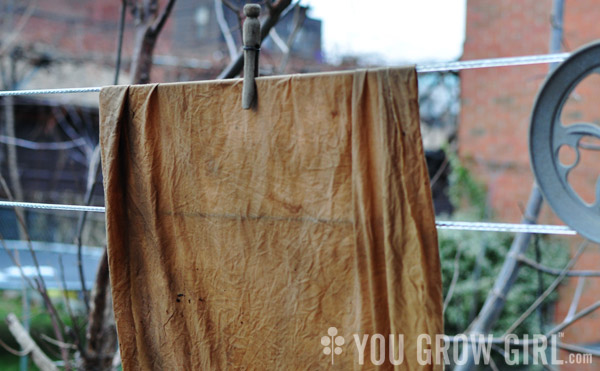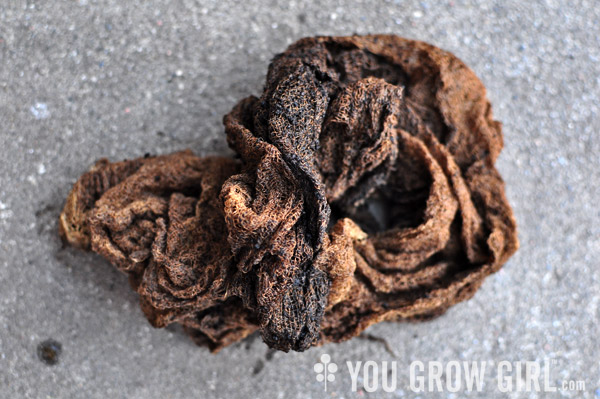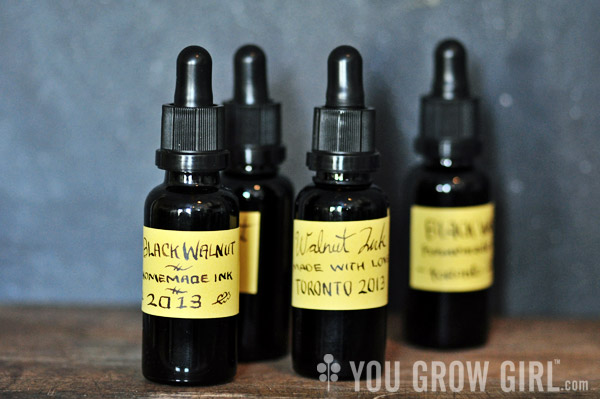
Header hand drawn by Davin Risk
Over the last year I’ve posted about some of my experiments in dyeing fabrics and threads with plants gleaned from my garden to be used in my winter, off-season stitching projects. Since then I have expanded beyond my own garden to use plant materials foraged from the world beyond. In the fall I had great success with goldenrod (Solidago) flowers. It turned old cotton sheets the most wonderfully soft shade of 70’s era yellow.
Around that time (mid-fall), the black walnut trees (Juglans nigra) started to drop their nuts. I had heard that they make a good dye and can be boiled down further to make a good quality, fade-proof, chestnut brown ink. Since Davin has been doing more ink work as of late, I thought it would be fun to collect a few nuts and experiment with using them as both a dye for my projects and an ink for his. The experiment has been a huge success so I thought I would share the process and the results with you here.

Cotton fabric that I dyed with black walnut.

Bottles of black walnut ink.
You Will Need:
- Several whole black walnuts
- A large non-reactive pot (I use an enamel stockpot reserved for dyeing projects)
- Gloves to protect your hands, optional
- Cheese cloth
- Metal sieve (optional)
- Rubbing alcohol
- Whole cloves (optional)
Forage and Ferment
For this project you will need whole black walnuts with their fragrant, green husks still intact. I collected 69 fruits, which turned out to be far more than one would need to produce a large quantity of ink. It took me ages to process it all. You could easily cut that number in half and come away with a nice batch of ink. I picked mine up off of the ground at the flea market we frequent, but I see black walnut trees all over the city, especially in older public parks. Their sticky green hulls are generally considered a nuisance and most people would appreciate it if you hauled a few away.
Back at home, I tossed the fruit into one of the large enamel stockpots that I use for dyeing, and forgot about them for several weeks so that they would have time to blacken and ferment. I’m sure they don’t need to sit around for quite that long, but I didn’t have a chance to get to the task.
Once blackened and soft, you can choose to pull away the fruit and discard the nut (we threw ours into the yard and the squirrels quickly scooped them up), or cook them whole and remove the nuts after.
Note: Once the nuts are blackened they leave a stubborn, persistent stain. I suggest wearing rubber gloves for the remainder of the process and protecting any surfaces that you are concerned about with plastic. Clean with cloth or rags that you don’t mind staining. Protect your clothing with an apron. If you can, cook the dye/ink in a non-reactive pot that is reserved for dyeing.

Round One: Cooking the Fruit
To begin, I added water to the pot, just enough to cover the fruit, and simmered on a medium-low heat on the stove for nearly an entire day. I then turned it off, put the lid on, and let the pot sit until the next morning.
Note: Black walnuts produce a strong smell as they cook. It isn’t toxic or nauseating, but I suggest cooking on a day when you can leave the windows or kitchen door open, or better yet, do the whole thing outside on a portable stove.

The next day I strained out the solids using cheesecloth set inside a metal sieve for stability. Don’t forget to wear your gloves!! I have since found large, cotton, drawstring bags that would have been much easier to use. I worked through my extra large pot of dye in batches, pouring the ink and sludge through the cheesecloth until it was full and then pulling up the sides and squeezing out as much of the colour as possible. I then set the solids aside and put them into a second pot with more water to cook on the stove. I have since used the liquid from this batch to dye fabrics and threads (photo near top of page), while the first batch was used to make ink. If you are only planning to make ink, you can go ahead and compost the solids. Please note: Black walnut contains a toxin called juglone that may injury or even kill some garden plants. Concentrations of juglone are high in the hulls. Ohio State University suggests composting the leaves for a minimum of 2 months and the bark for 6. Since I would have been adding mine to the compost in the winter months, I tossed it into my city’s green bin instead.

Round Two: Cook It Down
Once the solids were removed, I put the liquid back onto the stove and set it to simmer for several hours until it was thick and dark. I tested it a few times along the way by dipping a paintbrush into the ink and writing with it. I suggest cooking it down a little bit more than you want since it will be thinned out slightly by the addition of a preservative.
I then strained the liquid through a fine mesh sieve lined with fresh cheesecloth to ensure that all of the tinier bits were removed, and then poured it into large Mason jars to cool. If you have a large batch, I suggest breaking it down among a few jars, making sure that there is a few inches of space left in the jar so that the preservative can be added. I ended up with 2 jars of strong ink.
Once my ink was cooled to room temperature I poured rubbing alcohol into the jars, adding in about 20% of the volume of ink (I eye-balled it). Rubbing alcohol acts as a preservative to prevent the ink from going off or forming mould. I have found that it also helps the ink dry a little bit faster on paper.

You can leave your finished ink in large Mason jars or divide it into small, clean bottles for easy accessibility. I purchased these tinted dropper bottles, typically used for medicinal tinctures, at a local bottle supply store, but I also poured some into an old hinge-lid jar (I have seen these at the dollar store) and a used vanilla extract bottle. You may have bottles in your recycling bin that will work. I put a whole clove into each bottle for good measure. I had read that they make a good preservative, and even thought I had already added the alcohol, I figured it couldn’t hurt to double up.
Since we were giving a few bottles away as gifts, Davin used the ink to make hand drawn labels. They look great, but more importantly, we love the quality and consistency of the final ink. It goes on more smoothly than any of the inks we have purchased, especially when using a dip pen and nib. Not a bad haul considering the main ingredient was picked off the ground and cost absolutely nothing!
Related Resources:
Giveaway Details
I’d like to give away a bottle of our homemade black walnut ink to 2 readers.
All you have to do to enter is answer the following:
How would you use homemade ink/dye? As always, you can just type in “count me in,” and that will count as an entry, too.
I will be choosing 2 winners at random at midnight on January 20, 2014. Winners will be contacted by email.
I’d use them to label canned food. Thanks for counting me in.
My daughter loves to sketch and has recently been trying out different types of inks and pens. She would love to try your ink.
This would be great for silly handwritten valentines!
It’s lovely, I’d practice doing some fancy handwriting.
I would love to try to experiment using homemade inks for my printmaking!
I found the tutorial on black walnut ink fascinating. I am anxious to try this.
Nice! I’ll definitely have to try this next fall after this year’s crop of walnuts falls! In the meantime, I would use your ink in my watercolor paintings. I like the sepia tone of it, compared to the black ink I use!
Yes, the colour is great. A lot of things make black ink, but the brown is unique.
I’m a pagan, and would love some home made ink for spell writing! And thanks for the directions! It gives me a new use for the 40 million walnuts our tree flings at us every fall!
Wow! Count me in! I use ink all the time in my vast collection of fountain pens. And wow next walnut season I am going to try this. But in the mean time I sure would like to win a bottle of yours to use.
Make drawings with my dip-pens! Thank-you for sharing the recipe.
I’ve got a few journals that I’d love to write into with hand made ink. Thanks for the idea, even if I don’t win, I may eventually cook up a batch!
I’d use it to draw illustrations on my recipe cards. I like the various tones it gives…such a handmade look. Thanks for the great tutorial. I remember seeing black walnut trees in the same orchard where we picked cherries in Summerland. We didn’t know what those green orbs were until the farmer enlightened us. Very cool!
I’d love some to dye cotton fabrics for nature-themed quilts!
That’s one o my goals with the dyed fabrics. Eventually I will make a quilt of the various naturally dyed colours.
Labeling canned goods and writing in my garden journal.
I do pen and ink drawing, and it would be fun to experiment with black walnut ink.
When I was 14 I started a little card company with my best friend – we did hand illustrated cards with calligraphy and I think we charged $2 each or something ridiculous. Mostly teachers ordered them but we also did the name cards for wedding once too. I don’t think I’ve done any calligraphy in over 20 years now but found a bunch of my nibs in the basement recently during a fit of organizing. It would be fun to dust them off again!
I would use the ink for drawing and writing.
Oooh, this is marvelous! Id love to use this to create my apothecary labels, how magical! Ill have to start experimenting as well, thank.you for the inspiration!
I found a thrift store fountain pen with a calligraphic nip this fall and had a great time writing letters from Santa for the stockings, and fancying up the gift tags. I’d love to relearn my old calligraphy skills with old natural inks. Black walnut would be perfect for some tudor era projects. Maybe even find a goose wing and cut some quills. Thanks!
I would give it as a gift to my daughter.
I make greeting cards with botanical designs, and that color would look fantastic. Count me in!
Well I’ll be addressing wedding invites soon so this ink would be perfect for the calligraphy. Count me in!!
When I was a kid, penmanship was a class we had in school, but from my handwriting today you’d never know it. My sister (and mother) still have beautiful parochial school penmanship — I alas do not but I’ve returned to practicing it in my journal. It would be fun to practice with this ink using a variety of “writing” implements.
I would love to use this to write in my garden journal. I am not talented with drawing but I have nice handwriting and I could see how pretty this would be:)
When I was visiting Italy years ago, I met a farmer selling black walnut ink at a little market…your article brought back memories of a great trip…I still love to write and send real letters, I would love to write some with your walnut ink!
I want to try dyeing my own fabrics this year for my quilting :)
Wow, I’d love to give this to my SO who does pen and ink political cartoons. And I’d really like to make some. Time to start looking for black walnuts. Thanks!
Currently I am putting together the pieces to be used in a fiber art piece I have just finished designing. The piece calls for words to be “written” on the background materials…using walnut dyes to write the words in a variety of scripts would be the perfect answer to how to get the words permanently onto the fiber. Oh how wonderful it would be to have the ink to use.
Beautiful for labeling!
Wow, this would be the push I need to finally try Chinese calligraphy. I received a book a few years ago, but still never took that first step… count me in!
I am the genealogist of my family and would love to add caligraphic notes with such a lovely and traditional ink. I would love, of course, use scanning to prolong the life, but what a lovely touch you ink would give!
I am a soap artisan and am always looking for natural ways to produce creative and natural packaging for my all natural soaps and lotions. I would use the ink to make beautiful labels using calligraphy lettering and scroll work. I am excited for the opportunity. Thank you for providing the recipe.
I forgot to include the requested tag to my comment above so, Count me in!!
Thanks again!
I would give the ink to a writer friend of mine who uses a quill – he would love it!
I’ve been interested in making ink washes for my work on paper. I’d definitely use the black walnut ink in my mixed media work!
I also wonder, given the long simmering times, if a crock pot would be a good way to do this low and slow and outside (if it is too smelly). I imagine it might be easy to find a spare crock at the thrift store. Or perhaps roasting the concoction in the oven to conserve energy in your dedicated vessel, just like putting a dutch oven full of stew or chili in the oven for long cooking times?
I create a sketch of my garden with a legend at the bottom of all of the plants and flowers that I am growing. The ink would be a great organic addition to my sketches for seasons to come.
I would use them to design my own cards and fabrics with. And as a learning tool for my grand kids .
I would love to use your fabulous walnut ink to label all my homemade canned goods and also on craft projects such as fabrics on pillows, handbags and clothing!
I love using handmade inks, such as this for calligraphy… mostly love letters… and Valentine’s is coming up. In mythology Carya fell in love with Dionysus (a Greek God) and he turned her into a Walnut tree at the time of her death… so she could live on. Walnut ink makes me think romance! Perfect for Valentine’s writing and love letters.
I too would dye fabric to be used in my quilting.
My niece is really artistic so I’d surprise her with this black walnut ink if I’m the winner!
Great DIY Instructional! I plan to try this next Fall, now that I know how easy it is. I plan to use mine as a wood stain. Normal stain cost $8-15 a quart, think of how much money I can save. I will have to get back to you on the quality of using this as a stain :)
I have heard that it makes an excellent wood stain, but I haven’t tried it.
What a fantastic idea! Thank you for sharing how you did this. There are always a huge amount of walnuts around (in fact, the squirrels have been frantically digging them out of the snow since I missed picking up a lot of them — oops). I will definitely have to try this when the time comes! What a fantastic use of something I otherwise look at as an annoyance. (Well, annoying for me to pick up. I do like that it gives the squirrels food!)
The black walnut ink would be great for lettering on some notecards I want to create. I’d love to use some on a sign post I’m making but I’m not sure it would withstand the elements outside.
So glad I stumbled across your site; I’m hooked! Cheers!
I think homemade in would make me more likely to journal more regularly. One of the things I’ve discovered about myself is that I’m more likely to do something if I have beautiful handmade tools with which to do it. This certainly fits the bill.
I would bring it to my classroom to show my grade 9s how people used pens and ink, back in the “olden days”, before iPods and cell phones…they have no idea!
I hear they aren’t teaching kids cursive anymore, so it’s a dying art.
I would like to use the ink to give to my nine year old daughter Skarlette. She just learned to crochet and use a spindle. She wants to use natural dyes to dye the wool fibers that she spins to crochet gifts for friends and family. She would be thrilled; she has been following your blog with me for ideas for our urban garden!
Thank you, and Blessings!
I watched this process on Instagram… was so excited about it! I only recently moved from the east coast… I wonder if California has black walnuts… I’d love to try this myself!
Hehe… And I’m an illustrator, so the ink would be used for my illustrative works! I wonder if they’re waterproof… Would test them out with watercolors and my Dr. Martin dyes!
Always love the projects you two do!
Calligraphy on cards
Great idea! I used to have a large black walnut in my back yard when I lived in St. Paul, Minnesota about 10 years ago. Some neighborhood kids took some of the walnuts one year to make ink for a science project and I never heard how it turned out. Given your results, I guess I should have tried it as well. I would caution against composting the black walnut remains, however. Black walnuts have a chemical, juglone, that kills many plants including roses and tomatos.
Thank you for pointing this out! I had intended to mention that and can’t believe I missed it on subsequent edits. I did not compost mine for that reason — I tossed them into my city’s green bin instead.
I’d use it to calligraphy addresses on my friends wedding invitations.
I’d use the ink for tags on homemade gifts and preserves. And I’d also break out the old sketchbook, put on some music and candles, lock the world out and have a lovely sketchy evening to myself. Maybe I will do this whether I win or not…
LOVE this! There is a Black Walnut tree at the corner of our property. I’m often ducking for cover when one hits the metal roof on the shed. My husband experimented a little with homemade “paints” which I found fascinating – blueberry for example. I would love to paint with this ink! Reminds me of a garden at our local Thousand Islands Art Museum (formerly the Handweaving Museum – they have planted plants used in making dyes throughout history). Very interesting!
Your ink would make beautiful sketches in my garden journal.
I would share it with my very artistic 11 year old granddaughter , Avery, who loves to draw and paint. She is in gifted art classes and she would love to share black walnut ink drawings with her art teachers.
Writing thank you notes. I taught my daughters, 16 and 20, to write them years ago. It seems as old fashioned as making ink.
I would gift it, along with a calligraphy pen, to a very old dear friend who still handwrites me letters every week!
I would use it to make designs on fabric or give my seed packs proper pretty labels :)
Count me in! I would love to try this for my own inking projects and with my children’s calligraphy. We have our own tree, and it mainly feeds the squirrels. Would love to try this to determine if it was worth the fight!
Art quilting, fabric painting, labels, sketching…oh the possibilities are endless! Definately count me in! Thanks!!!